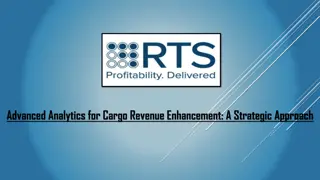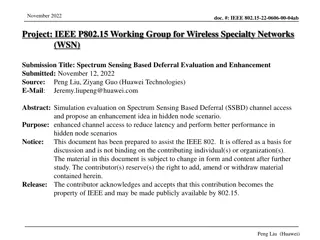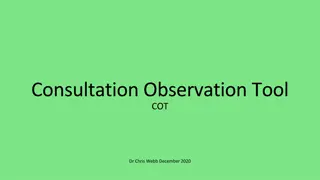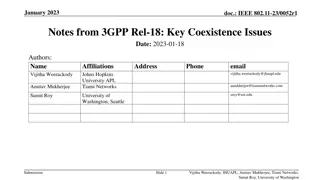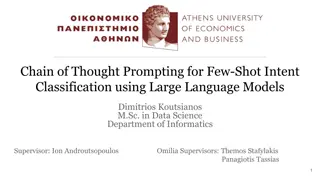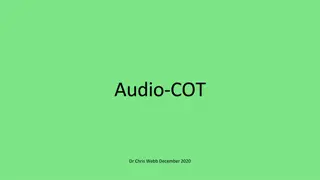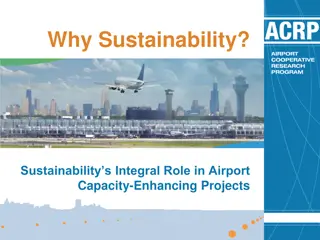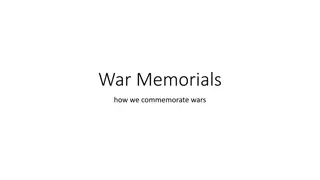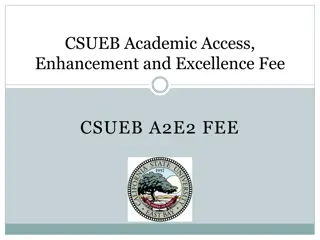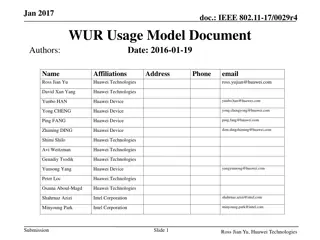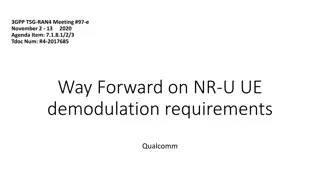COT Usage Scenarios and LCP Enhancement Discussion
This content delves into the clarification of COT usage scenarios and discusses the handling of each scenario, including LCP enhancement on L2 destination ID and/or CAPC restriction. Various observations and proposed solutions are presented to address the key issues related to COT utilization. Stakeholders provide insights and considerations for improving the handling of COT in the context of RAN1 agreements.
Download Presentation

Please find below an Image/Link to download the presentation.
The content on the website is provided AS IS for your information and personal use only. It may not be sold, licensed, or shared on other websites without obtaining consent from the author.If you encounter any issues during the download, it is possible that the publisher has removed the file from their server.
You are allowed to download the files provided on this website for personal or commercial use, subject to the condition that they are used lawfully. All files are the property of their respective owners.
The content on the website is provided AS IS for your information and personal use only. It may not be sold, licensed, or shared on other websites without obtaining consent from the author.
E N D
Presentation Transcript
[AT121][508][V2X/SL] COT usage scenario and LCP enhancement (OPPO) Scope: Clarify the COT usage scenarios (excluding reception of multiple COTs) and discuss how to handle each scenario (including LCP enhancement on L2 destination id and/or CAPC restriction). With consideration of RAN1 agreements. Intended outcome: Discussion summary in R2-2302035 Deadline: Comeback at 3/3 CB session
Background Proposal 3 whether the selected Destination is associated with the COT initiating UE and CAPC value). [LG]: Support the proposal. Minimum change of LCP is required to use COT (based on RAN1 agreements). [Xiaomi]: For L2 destination id aspect, it is still FFS in RAN1. For CAPC aspect, we can consider alternative solution (e.g. assistance information is provided by responding UE to initiating UE, the initiating UE assigns based on the received information, then we may not need LCP change in the responding UE when COT is used). [Ericsson]: L2 destination id restriction is clear at least for UC (to RAN1 agreement). [Lenovo]: Support the proposal. [Vivo]: It is similar to a NR-U case where DCI indicates CAPC value, but in NR-U there was no change of LCP due to that. [Huawei, Lenovo]: It was not specified because it was clear requirement. Also it is for mode 1 operation, so the gNB is well aware of the status of the UE. [LG]: Compared to NR-U, in SL-U LCP has a L2 destination id selection. [OPPO]: Companies may want to see whole cases and see the solution for each case. In the LCP procedure, the responding UE considers the COT info (i.e., including
Observation It seems there would be anyway some cases where the COT cannot be used, (e.g., 1/ MAC PDU generated before COT arrival which does not satisfy the COT requirement, or 2/ MAC PDU has not been generated but no data in RLC buffer satisfying COT requirement and etc.). It does not exclude other factors to be considered here, e.g., resource selection. It seems there would be anyway cases where the COT can be used (e.g., if following legacy LCP, the generated MAC PDU already satisfies the COT requirement)
Observation The key issue seems for the case where 1) If following legacy LCP (no change), the MAC-PDU to be generated does not satisfy the COT requirement 2) Yet if change LCP a bit (destination-selection and/or LCH- selection), the MAC-PDU to be generated can satisfy the COT requirement What the UE should do
Observation: Solutions on the table Solution-1: Make use of the COT (i.e., type-2 LBT) + an improved LCP to ensure MAC-PDU satisfy the COT requirement Solution-2: Not make use of the COT when not meeting the COT requirement, but rely on type-1 LBT, and rely on the legacy LCP procedure Solution-3: Make use of the COT + legacy LCP + a message to notify the CAPC info to the initiating UE
Q: How do we proceed Unless we identify infeasibility of either solution Way-out-A: trying to down-select between the 2 solutions Way-out-B: trying to allowing both (I,e,, either to change the LCP (FFS what is the change is), or do not change the legacy LCP (FFS whether we need some information to the initiating UE), and UE can select which solution to use. FFS on spec impact.
MoM [LG] we should clarify that the key case is that pdu has not been generated [Lenovo] do we need to clarify which part of LCP is to be affected. [Xiaomi] if we can support some BSR-like solution, we can avoid this issue. [vivo] the point is to use the COT or not. [E///] the key point is whether responding UE can use the COT to transmit to initiating UE. [ZTE] support solution-3. + still pending whether the COT is to be used for a 3rdUE. Type-1 is always a solution. [QC] besides the dest/LCH restriction, another factor is whether the resource selection result overlap with COT. [Lenovo] solution-1/3 is preferred
MoM [Apple] we need to focus on the specific case. Solution-1 is better. Solution-3 is a bit unclear at this stage. [IDC] solution-1 is preferred. Solution-3 has some issue for GC. [HW] Similar to NR- U. R1 is also looking into solution that some CAPC info is included in the COT. Solution-1/3 is preferred.
MoM [IDC] maybe we can allow both solution-1/2, so that UE can select in-between. [Xiaomi] 3>2>1. we have a solution for GC. [Intel] We prefer Solution 1; also share IDC view that both 1/2 may be allowed. Not prefer 3. [LG] same view as IDC, intel. [HW] want to exclude option-2. [MTK] agree with IDC, both solutions can be allowed. [E///] similar view as HW. Solution-1 and/or 3 are preferred. [vivo] if exclude solution-2, seems to mandate the UE to use the COT when received. At least we need to avoid that misunderstanding in solution-1. [ZTE] do not see share COT is always available, type-1 is the default way-out.
MoM [QC] based on our simulation, we do not see gain from solution-1 over solution-2. even though the intention is to max COT sharing, it may end up with collision between Ues performing type-2 LBT. [HW] we see at least solution-2 enables more cases for responder UE to make use of the COT.
Recommended WF UE can select 1/ either to do a changed-LCP, in order to satisfy the COT requirement, and to do the type-2 LBT (How to do the LCP can be decided after RAN1 agreement) 2/ or to do a legacy-LCP, using either type-1, or type-2 LBT (which relies on the assistance message to initiating UE, which is still FFS) FFS on spec impact, e.g., conditions for UE to choose either solution.


